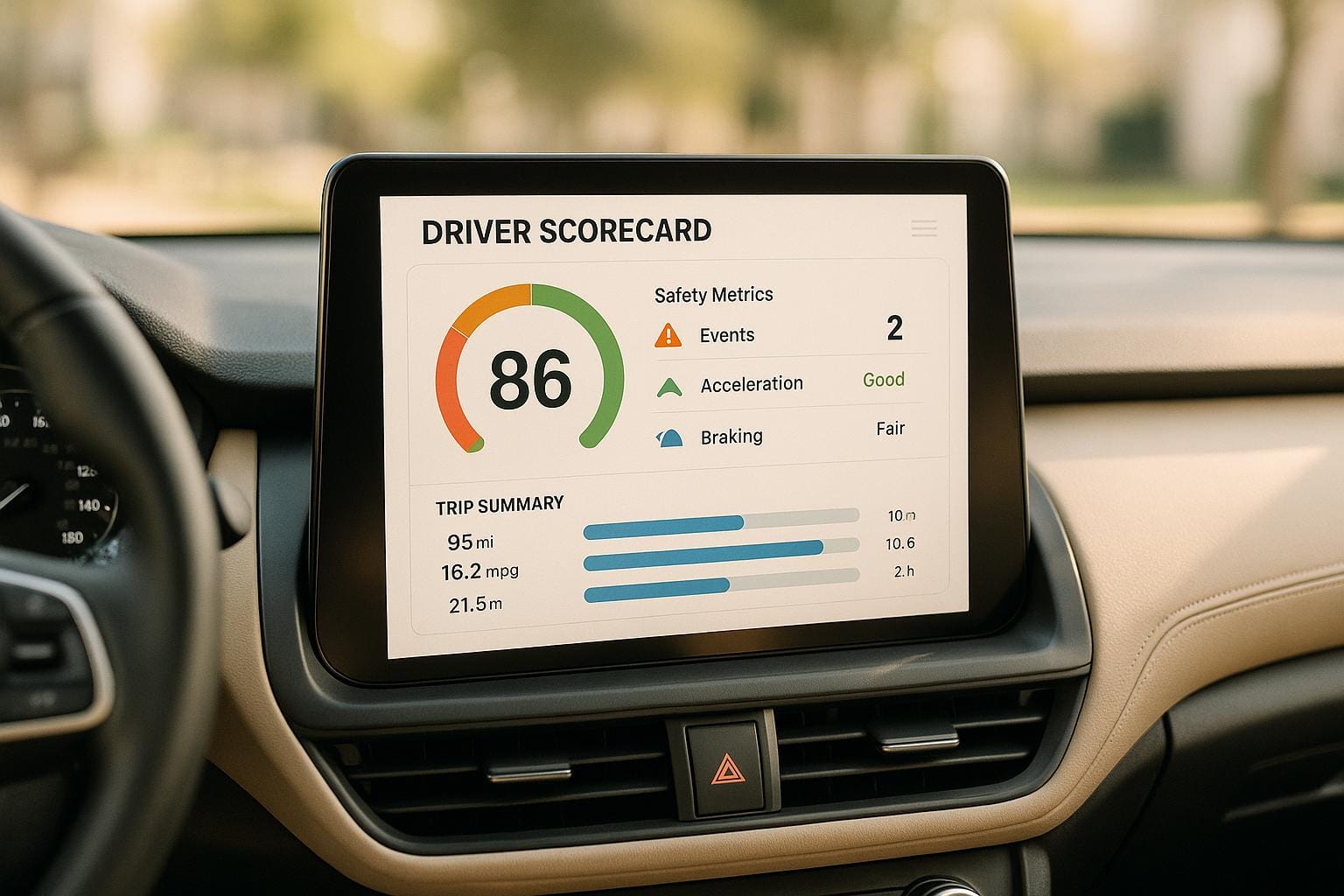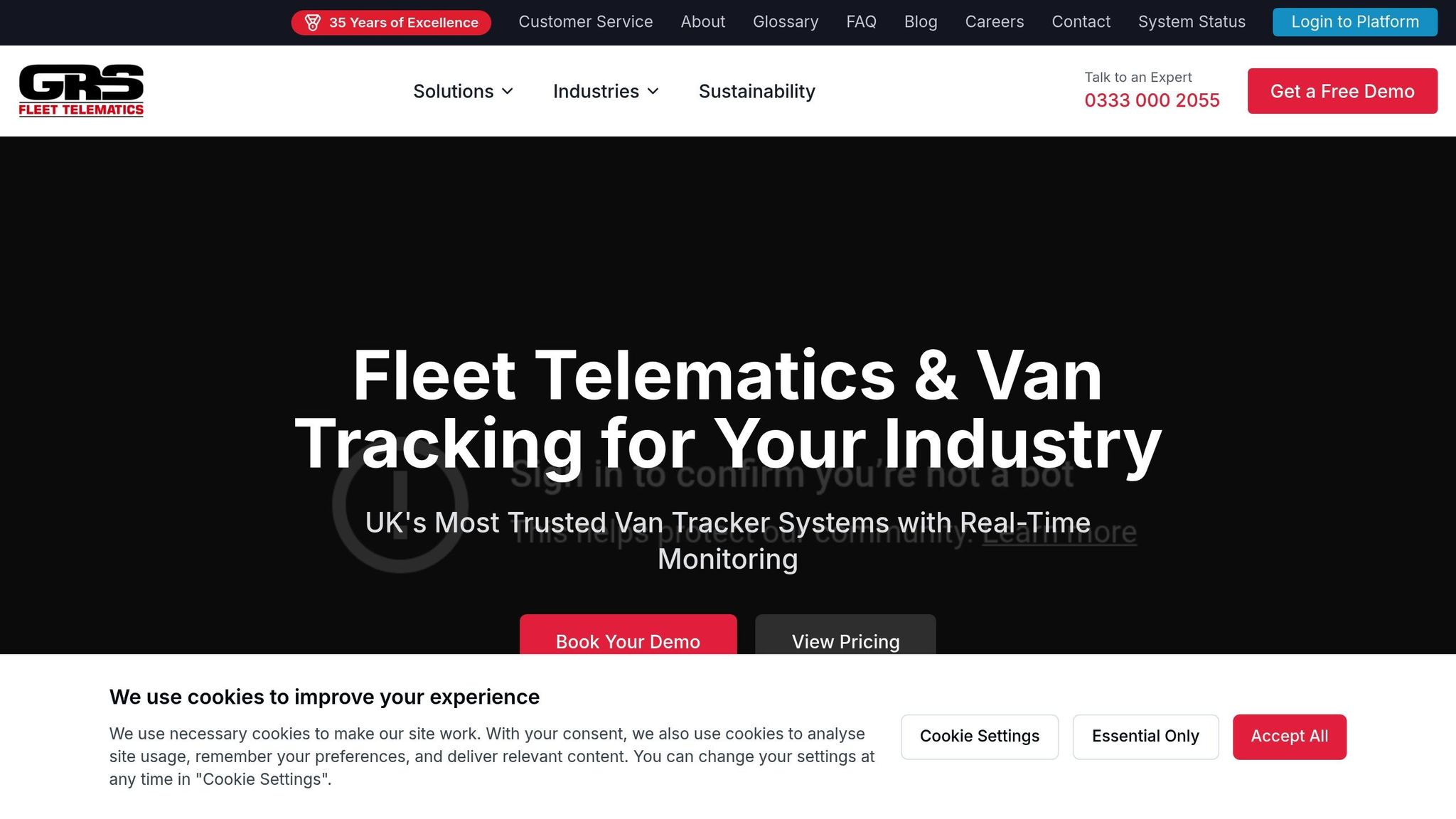Driver Scorecards: Reduce Costs with Data
Michael Bar

Driver scorecards use data from telematics and GPS systems to monitor driving behaviours like speeding, harsh braking, and idling. These tools help UK fleet managers improve safety, reduce costs, and enhance driver performance. By identifying risky habits, scorecards enable targeted coaching, lower fuel consumption, and fewer accidents - saving businesses thousands annually. Real-time data and AI-powered tools ensure timely interventions, while tailored metrics meet specific fleet needs. With examples of fleets cutting accident rates by 40% or saving £20,000 in fuel costs, driver scorecards prove to be a practical solution for managing expenses and improving operations efficiently.
TN360 Driver Scorecards

Key Data Metrics Tracked by Driver Scorecards
Driver scorecards are a crucial tool for fleet managers, offering insights into driving behaviours that influence safety and costs. By tracking these metrics, managers can identify areas for improvement and implement strategies that directly impact operational expenses.
Driver Behaviours Monitored
Driver scorecards focus on several key behaviours that affect both safety and cost management. Speeding violations are a top priority, as speeding contributes to nearly 29% of all traffic fatalities in a year. To address this, fleet managers can use real-time speed alerts with customised thresholds.
Another critical area is harsh braking and rapid acceleration, which not only increases fuel consumption but also leads to higher wear and tear on the vehicle. Aggressive driving can reduce fuel efficiency by 15%–30% on highways and 10%–40% in stop-and-go traffic. This behaviour also accelerates brake and tyre wear, adding to maintenance costs.
Engine idling time is another behaviour with significant cost-saving potential. For instance, Orkin, a pest control company, reduced idling by 8.4% through a driver contest using telematics, saving approximately £50,000 in just three months.
Mark Donahue, Fleet Analytics Manager at Emkay, highlights the benefits: "Clients are utilising the devices to monitor idling time, trip history, and route optimisation to identify risks and reduce overall fuel expenditures".
Other monitored behaviours include seatbelt usage, sharp cornering, and mobile phone use, all of which contribute to safety and compliance.
| Metric | Safety Impact | Cost Reduction | Compliance Value | Environmental Benefit |
|---|---|---|---|---|
| Speed Limit Violations | Very High | High | Very High | High |
| Hard Braking Events | Very High | Very High | Medium | High |
| Rapid Acceleration | High | Very High | Medium | Very High |
| Engine Idling Time | Low | Very High | Medium | Very High |
| Seatbelt Usage | Very High | Low | Very High | None |
| Sharp Cornering | High | High | Low | Medium |
| Phone Use While Driving | Very High | Medium | Very High | Low |
Data Sources for Scorecards
Driver scorecards rely on diverse data sources to provide an accurate picture of driving performance. Telematics and electronic logging devices (ELDs) play a central role, capturing data on vehicle location, compliance, and operational behaviour. These tools integrate with GPS fleet tracking systems, engine control modules, and advanced driver assistance systems to create detailed driver profiles.
AI dashboard cameras add another layer of insight by providing visual evidence of driving events. These cameras analyse behaviours like speeding, harsh braking, and sharp cornering in real time, reducing accidents by up to 60%. SureCam's AI In-Cab Nudges technology, for example, has reduced alert volumes by up to 90%.
David Gilstrap, Director of Risk Management at Concrete Strategies, explains: "With SureCam, we've transformed how we manage risk. The video evidence has been instrumental in protecting our drivers, reducing liability, and helping us coach our team more effectively. It's made resolving claims faster and fairer, which has saved us significant time and money".
Fleet management software consolidates this data, combining telematics, camera footage, and compliance records into unified driver profiles.
A fleet safety specialist notes: "A well-designed driver scorecard programme is one of the most powerful tools a fleet can use to improve driver behaviour, enhance safety, and control operational costs".
This integration allows for immediate analysis and supports proactive interventions.
The Importance of Real-Time Data
Real-time data transforms driver scorecards into proactive management tools. By identifying risky driving behaviours as they happen, fleet managers can address issues immediately, rather than waiting for monthly reviews. This approach enables timely feedback and focused coaching conversations based on specific incidents.
Jeffery Benore, CEO of Benore Logistics Systems Inc., underscores the value of accuracy: "For scorecards to be effective and fair, businesses must use accurate, real-time data and provide transparency about how metrics are used".
AI-powered systems process driving events in real time, integrating data from telematics, dash cams, and ELDs to identify patterns and trigger alerts. This constant monitoring not only enhances safety but also supports cost control by addressing problems before they escalate.
Real-time data also enables automated coaching workflows, delivering instant feedback to drivers via in-cab displays or mobile apps. This immediate response helps reinforce good habits and correct unsafe behaviours before they become routine. By combining AI-driven dash cams, telematics, and customisable scorecards, fleets can simultaneously improve safety and manage costs.
Fleet managers can tailor scorecards to focus on the metrics most relevant to their operations, ensuring that real-time alerts address the behaviours with the greatest impact on safety and expenses.
How Driver Scorecards Help Reduce Costs
Driver scorecards connect driving habits directly to costs, offering clear opportunities for savings. By addressing poor driving behaviour with precise data, businesses can cut expenses related to fuel, vehicle maintenance, insurance, and accidents. Below, we explore how these insights support cost-saving strategies.
Impact on Fuel Efficiency and Maintenance
Driver scorecards monitor behaviours like speeding, harsh braking, rapid acceleration, and idling. This data helps managers identify fuel-wasting habits and implement measures like anti-idling policies. With fleet management software tracking fuel consumption, managers can spot drivers who consistently use more fuel than necessary and take steps to address the issue. Backed by scorecard data, these policies encourage better habits, such as turning off engines during stops and maintaining steady speeds.
Better driving habits don’t just improve fuel efficiency - they also reduce wear and tear on vehicles, cutting maintenance costs. By using scorecards to guide targeted training, businesses can maximise these savings. Beyond fuel and maintenance, safer driving also lowers insurance costs and accident-related expenses.
Lowering Insurance Premiums and Accident Costs
Safer driving practices, as highlighted by scorecards, lead to fewer accidents and lower insurance premiums. Accidents cost fleets an average of £13,200 per crash, contributing to an estimated £48 billion in annual losses. According to the National Association of Fleet Administrators (NAFA), around 20% of fleet vehicles are involved in accidents each year.
Improved safety records, supported by scorecard data, can help businesses negotiate better insurance rates. Many insurers now use telematics data to reward fleets with strong safety records. Scorecards also enable targeted training to tackle risky behaviours before they lead to accidents. Regular reviews provide drivers with constructive feedback, helping them improve.
Identifying High-Risk and High-Performing Drivers
Driver scorecards reveal individual risk patterns, which is essential for managing expenses. Data shows that 10% of drivers are responsible for 40% of crashes, and accident repairs make up about 14% of fleet costs. With fleet accident rates averaging 20%, and 40% of those accidents being preventable, identifying high-risk drivers is a critical cost-control measure.
Telematics data from scorecards allows managers to address specific risky behaviours through focused coaching and ongoing training programmes. For example, a services fleet with a 16.4% collision rate worked with Element Fleet Management to implement a risk management programme. Over five years, they reduced collisions by 29.3%, avoiding 1,109 accidents and saving approximately £2.7 million in repair costs.
Best Practices for Implementing Driver Scorecards in UK Fleets
To achieve cost savings and improved performance, implementing driver scorecards requires careful planning and clear communication.
Setting Up and Integrating Scorecards
Start by identifying the specific needs of your business. Focus on driving behaviours that have a direct impact on costs, such as speeding, harsh braking, rapid acceleration, and excessive idling.
Next, evaluate how telematics can be integrated into your existing systems. This step ensures that data flows smoothly between platforms. Plan the integration by scheduling regular data transfers, establishing preparation routines, and conducting thorough testing before launching the system. Once live, monitor its performance consistently to ensure it meets expectations.
Engaging Drivers and Building Transparency
After setting up the technical side, the next step is to engage drivers effectively.
Gaining driver support is fundamental to the success of any scorecard programme. Clearly explain which driving metrics are being tracked, why they are important, and how the data will be used. This transparency helps to build trust and avoid any misunderstandings.
Focus on positive reinforcement by celebrating and rewarding safe driving behaviours rather than solely highlighting mistakes. As Sherry Calkins, Senior Vice President of Global Strategic Accounts at Geotab, puts it:
"When designed thoughtfully, driver scorecards motivate positive habits rather than serving as punitive measures and can improve the driver experience."
Providing real-time feedback is another way to encourage continuous improvement, making it easier for drivers to adjust their habits and maintain safe practices.
Legal and Cultural Considerations
Once the technical and engagement aspects are in place, it’s essential to address legal and cultural factors. Ensuring compliance not only avoids fines but also builds a fair and respectful workplace.
UK fleet operators must comply with the Data Protection Act 2018 and UK GDPR when implementing driver scorecards. Conducting a Data Protection Impact Assessment (DPIA) is a key step to identify and address any privacy risks. Collect only the data that is absolutely necessary, and ensure robust security measures are in place to protect it.
Communicate openly with employees about the metrics being monitored and why they are important. Opt for monitoring methods that are as unobtrusive as possible, and consult with staff to ensure the approach is both relevant and fair. Additionally, be mindful of cultural sensitivities to ensure that no group feels unfairly targeted or discriminated against.
Finally, regularly review and update the scorecard metrics to keep them in line with changing business priorities, safety regulations, and industry standards.
Using GRS Fleet Telematics for Driver Scorecards

Driver scorecards are a powerful tool for managing costs, and GRS Fleet Telematics provides a tailored solution for UK fleets to maximise their effectiveness. With precise data and reliable tracking technology, GRS enables fleet managers to measure performance accurately and achieve tangible savings.
GRS Fleet Telematics' Advanced Tracking Solutions
At the heart of GRS Fleet Telematics is its dual-tracker technology, which combines a primary wired tracker with a Bluetooth backup to ensure uninterrupted monitoring. This system boasts an impressive 91% recovery rate for stolen vehicles. Beyond theft recovery, this technology captures vital driving metrics, offering detailed insights into driver behaviour. These metrics seamlessly integrate with scorecard analytics to provide a complete performance overview.
Geofencing tools further enhance monitoring by automatically logging driver activity within specific areas, such as depots or restricted zones. For mixed fleets, including electric vehicles, the system also tracks energy usage in real time - critical for managing battery efficiency and controlling costs associated with aggressive driving.
Turning Data into Actionable Insights
GRS Fleet Telematics transforms raw data into actionable insights using its integrated dashboard. Fleet managers can access all performance data in one place, with the platform automatically calculating scorecard metrics based on pre-set parameters. Custom thresholds can be established for various driving behaviours, with alerts triggered when these limits are breached.
The platform also includes route optimisation tools, adding valuable context to driver performance evaluations. For instance, if a driver’s fuel consumption is unusually high, the system can help determine whether this is due to challenging routes or driving habits. By connecting driving behaviours like harsh braking to vehicle health monitoring, fleet managers can also anticipate maintenance needs, reducing downtime and repair costs.
Flexible and Scalable Solutions for UK Fleets
GRS Fleet Telematics offers its advanced scorecard systems at flexible pricing, making them accessible to fleets of all sizes. Subscriptions start at just £7.99 per vehicle per month, which includes SIM data, dedicated account manager support, and full access to the platform.
To meet the varying needs of different fleets, GRS provides three hardware packages:
| Package | Price | Features |
|---|---|---|
| Essential | £35 | Wired tracker for real-time tracking |
| Enhanced | £79 | Primary tracker with Bluetooth backup for improved theft protection |
| Ultimate | £99 | Both trackers plus immobilisation for maximum security |
These options make it easy for smaller fleets to start with basic functionality and scale up as their operations grow. As the GRS Leadership Team puts it:
"Our platform has been proven globally across fleets of all sizes. Whether you manage 5 vehicles or 500, our GPS tracking system for car fleets grows seamlessly with your business."
For businesses seeking customisation, GRS also offers a white-label solution, allowing companies to incorporate driver scorecards into their existing fleet management systems under their own branding. Additionally, the pay-per-recovery model eliminates upfront recovery fees, and free installation is available when paired with fleet branding services through GRS Fleet Graphics.
Telematics-driven insights can significantly improve fleet efficiency, with potential fuel savings of up to 15%. These savings can help offset subscription costs, making GRS Fleet Telematics an affordable and effective solution for optimising fleet performance.
Conclusion: Driving Efficiency and Savings with Data
Driver scorecards are transforming fleet operations across the UK, offering a practical way for businesses to cut costs and improve safety through data-driven insights. For instance, 91% of businesses have reported improved safety by using driver performance coaching, while 58% have seen better driver performance through rewards programmes.
The benefits of driver scorecards go well beyond just tracking metrics. Con-way Transportation (now XPO Logistics) managed to cut fuel costs by 12% by implementing advanced driver training programmes focused on fuel-efficient driving techniques. Similarly, Schneider National achieved a 40% reduction in accidents through targeted training, leading to lower repair costs, fewer insurance claims, and reduced vehicle downtime.
These success stories highlight the potential of scorecards for UK fleets. One national delivery service saw a 25% improvement in safety scores, which contributed to a noticeable drop in annual insurance premiums. Meanwhile, a UK construction company used telematics data to cut vehicle idling by 30%, saving over £20,000 in fuel costs within just one year.
With these proven savings in mind, GRS Fleet Telematics offers UK businesses tools designed to enhance efficiency and control costs. Their platform can help fleets reduce fuel consumption by up to 15% through smarter routing and better driving habits. On top of that, they provide an impressive 91% vehicle recovery rate and affordable pricing starting at just £7.99 per month.
FAQs
How can driver scorecards help fleet operators save on fuel and maintenance costs?
Driver scorecards are an effective way to cut down on both fuel and maintenance costs. By monitoring driving habits like smooth acceleration, steady speeds, and gentle braking, they encourage behaviours that can improve fuel efficiency. In fact, adopting these practices can reduce fuel consumption by as much as 33%.
But the benefits don't stop there. Scorecards also help reduce vehicle wear and tear. By promoting safer driving, they limit harsh braking, rapid acceleration, and other actions that often lead to expensive repairs. Over time, this not only lowers maintenance bills but also helps fleet operators get more mileage out of their vehicles.
How can fleet managers effectively implement and integrate driver scorecards into their operations?
To make driver scorecards work effectively, fleet managers should concentrate on a few practical steps:
- Get management on board early to align the initiative with the company's overall goals.
- Involve drivers in the process by highlighting the benefits, like safer driving and potential savings.
- Emphasise behaviours over raw numbers, offering constructive feedback to help drivers improve.
- Define clear goals and communicate them openly with the team to ensure everyone is on the same page.
- Use visual dashboards to simplify performance tracking and make the data easy to understand.
Following these steps can make the integration process smoother and help your fleet get the most out of driver scorecards.
How can businesses stay compliant with UK data protection laws when using driver scorecards to track driving behaviour?
To meet UK data protection laws, businesses must be clear with drivers about the data they’re collecting and the reasons behind it. Before any tracking starts, it’s crucial to get explicit consent. Additionally, the use of this data should be strictly for legitimate business purposes.
Adhering to UK GDPR principles is key. This includes collecting only the data you truly need, keeping it accurate, and safeguarding it from unauthorised access. Regularly updating your policies and ensuring staff receive proper training on data protection are practical steps to stay compliant.